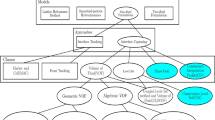Abstract
A new version of a computational method, Vorticity Confinement, is described. Vorticity Confinement has been shown to efficiently treat thin features in multi-dimensional incompressible fluid flow, such as vortices and streams of passive scalars, and to convect them over long distances with no spreading due to numerical errors. Outside the features, where the flow is irrotational or the scalar vanishes, the method automatically reduces to conventional discretized finite difference fluid dynamic equations. The features are treated as a type of weak solution and, within the features, a nonlinear difference equation, as opposed to finite difference equation, is solved that does not necessarily represent a Taylor expansion discretization of a simple partial differential equation (PDE). The approach is similar to artificial compression and shock capturing schemes, where conservation laws are satisfied across discontinuities. For the features, the result of this conservation is that integral quantities such as total amplitude and centroid motion are accurately computed. Basically, the features are treated as multi-dimensional nonlinear discrete solitary waves that live on the computational lattice. These obey a “confinement” relation that is a generalization to multiple dimensions of 1-D discontinuity capturing schemes. A major point is that the method involves a discretization of a rotationally invariant operator, rather than a composition of separate 1-D operators, as in conventional discontinuity capturing schemes. The main objective of this paper is to introduce a new formulation of Vorticity Confinement that, compared to the original formulation, is simpler, allows more detailed analysis, and exactly conserves momentum for vortical flow. First, a short critique of conventional methods for these problems is given. The basic new method is then described. Finally, analysis of the new method and initial results are presented.
Similar content being viewed by others
References
Lax, P. D. (1957). Hyperbolic Systems of Conservation Laws II. Comm. Pure Appl. Math. 10, 537-566.
Harten, A. (April 1978). The artificial compression method for computation of shocks and contact discontinuities III, Self-adjusting hybrid schemes. In Mathematics of Computation, Vol. 32, No. 142, pp. 363-389.
Fan, M., Wenren, Y., Dietz, W., Xiao, M., and Steinhoff, J. (December, 2002). Computing blunt body flows on coarse grids using vorticity confinement. J. Fluid Eng. 124, 876-885.
Wenren, Y., Fan, M., Dietz, W., Hu, G., Braun, C., Steinhoff, J., and Grossman, B. (2001). Efficient Eulerian computation of realistic rotorcraft flows using vorticity confinement, AIAA-01-0996.
Steinhoff, J., Wenren, Y., Braun, C., Wang, L., and Fan, M. (2002). Application of vorticity confinement to the prediction of the flow over complex bodies. In Caughey, D. A., and Hafez, M. M. (eds.), Frontiers of Computational Fluid Dynamics 2002, World Scientific, pp. 197-226.
Fan, M., Dietz, W., Wenren, Y., and Steinhoff, J. Computing complex flows on coarse grids using vorticity confinement, AIAA-2002-0135.
Steinhoff, J., Mersch, T., and Wenren, Y. (1992). Computational vorticity confinement: Two dimensional incompressible flow. In Proceedings of the Sixteenth Southeastern Conference on Theoretical and Applied Mechanics, pp. 73-82.
Steinhoff, J., Wang, Clin, Underhill, D., Mersch, T., and Wenren, Y. (1992). Computational vorticity confinement: A non-diffusive Eulerian method for vortex-dominated flows, UTSI preprint.
Steinhoff, J. (1994). Vorticity confinement: A new technique for computing vortex dominated flows. In Caughey, D. A., and Hafez, M. M. (eds.), Frontiers of Computational Fluid Dynamics, Wiley, pp. 235-264.
Wenren, Y., Steinhoff, J., Wang, L., Fan, M., and Xiao, M. (June 2000). Application of vorticity confinement to the prediction of the flow over complex bodies. AIAA Paper No. 2000-2621, Fluids 2000, Denver, CO.
Steinhoff, J., Puskas, E., Babu, S., Wenren, Y., and Underhill, D. (July 1997). Computation of thin features over long distances using solitary waves. AIAA Proceedings, 13th Computational Fluid Dynamics Conference, pp. 743-759.
Steinhoff, J., and Underhill, D. (1994). Modification of the Euler equations for vorticity confinement application to the computation of interacting vortex rings, Physics of Fluids 6, 2738-2743.
Stanley, Osher, Private Communication.
Orszag, S. A. (1971). Numerical simulation of incompressible flows within simple boundaries: Accuracy. J. Fluid Mech. 49, 75-112.
Kim, J., and Moin, P. (1985). Application of a fractional step method to incompressible Navier–Stokes equations. J. Comp. Phys. 59, 308-323.
Adams, J., Swartztrauber, P., and Sweet, R. (1981). FISHPAK Library for Solution of Separable Partial Differential Equations, Version 3.1, National Center for Atmospheric Research, Boulder, CO.
Srinivasan, G., Baeder, J., Obayashi, S., and McCroskey, W. (Oct. 1992). Flowfield of a lifting rotor in Hover: A Navier–Stokes simulation. AIAA Journal, 30, No. 10, pp. 2371-2378.
Marquina, A. (1994). Local piecewise hyperbolic reconstruction of numerical fluxes for nonlinear scalar conservation laws. SIAM J. Sci. Comput. 15, 892-915.
Marquina, A., and Osher, S. (2000). Explicit algorithms for a new time dependent model based on level set motion for nonlinear deblurring and noise removal. SIAM J. Sci. Comput. 22, 387-405.
Lugt, H. (1983). Vortex Flows in Nature and Technology, Wiley, NY.
Bridgeman, J., and Dietz, W. (Jan. 2002). Vorticity Confinement Modeling of Dynamic Stall with Tight Structural Coupling, American Helicopter Society Aerodynamics, Acoustics, and Test and Evaluation Specialists Meeting, San Francisco, CA.
Author information
Authors and Affiliations
Rights and permissions
About this article
Cite this article
Steinhoff, J., Fan, M., Wang, L. et al. Convection of Concentrated Vortices and Passive Scalars as Solitary Waves. Journal of Scientific Computing 19, 457–478 (2003). https://doi.org/10.1023/A:1025376630288
Issue Date:
DOI: https://doi.org/10.1023/A:1025376630288




